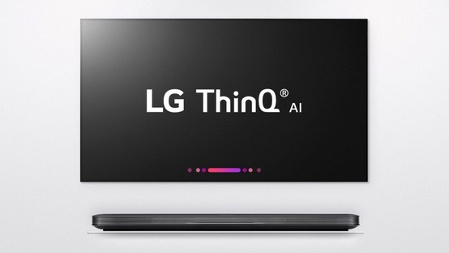CES 2018: Big, Thin and Very Smart is TV Theme
LAS VEGAS—Adding new meaning to the ubiquitous “smart television,” LG, Samsung, Sony and other manufacturers unveiled plans to put artificial intelligence capabilities into future displays, including deals with Amazon, Google and others to integrate their voice-response personal assistants into various devices. The blizzard of new—or updated—TV-related technologies unveiled at CES included “micro light emitting diode” (MLED) as an alternative to OLED and QLED, plus the latest iteration of thin “roll-up” (window shade) display panels.

ATSC 3.0 technologies, meanwhile, are popping up on the periphery of the sprawling CES exhibit halls, including presentations by the Pearl TV consortium and Sinclair Broadcasting about their plans for NextGen TV.
Although the CES exhibit halls officially open on Tuesday (Jan. 9) morning, vendors previewed their products on Sunday night and Monday. In addition to the familiar—and competitive—products from familiar Japanese and Korean manufacturers, Chinese companies such as TCL and Hisense aggressively stepped up their flat-panel offerings, and nVidia, the California chip-maker known for its game processors and AI developments, jumped into the display business.
nVidia’s first monitor is a 65-inch 4K “big format gaming display”(BFGD), which will feature low latency (a “must” for gamers) plus 120Hz refresh rates, full-array backlighting, a peak brightness of 1,000 nits and full DCI-P3 color gamut support. nVidia will work with ASUS, Acer and Hewlett-Packard to build the screens, which analysts point out is a group without much experience in producing big-screen displays. For now, nVidia said that it expects customers to use these large screen at their PC/gaming locations—not as primary television viewing monitors.

LG has set up an open partnership model with Google and Amazon to use their voice controlled AI systems for TVs and for other LG devices, including appliances, on the “ThinQ” platform. LG’s OLED TV sets use an Alpha 9 processor and include 4K HDR and Dolby Atmos sound. LG also unveiled Super UHD LCD products with “nano cell” display, which the company said will provide richer, more accurate colors from wider viewing angles.
Samsung’s new line-up includes a 146-inch “self-emissive” LCD using the MLED technology which puts more than 10,000 separate LED dimming zones on the screen. MLED uses Quantum Dots arrayed atop an inorganic self-emissive diode, which Samsung claims will eliminated heat or color degradation. Although Samsung does not appear ready to bring the device to market quickly, analysts said that presentation suggests that MLED is relatively close to delivery.
Samsung also unveiled 8K “micro full array sets,” including 85-inch and 65-inch models which use a lighting system that delivers 4,000 nits of brightness. The company has also developed 8K upscaling algorithms, which it says enhance detail and pixel depth, remove jagged edges and reduce video noise.
The professional video industry's #1 source for news, trends and product and tech information. Sign up below.
Panasonic introduced its first UHD OLEDs and UHD Blu-ray players, although its displays will not be sold in the U.S. now, except to the professional/production market. A company executive told TV Technology that Panasonic has not abandoned the U.;S. market, despite its shifting focus in recent years toward enterprise solutions (its CES exhibit focuses on smart cities, vehicle and other non-video-centric products). Nonetheless, the Panasonic demo included products that support HDR in devices ranging from cameras and video security systems.
Among the new offerings from Chinese makers, Hisense has integrated Amazon’s Alexa into some of its TV sets and is using quantum dot technology. TCL has added next-generation Roku TV to its line.
ANALYST PERCEPTION PLUS NEXTGEN TV PLANS
“It’s not about the display; it’s about the processor,” said Greg Harper, president of Harpervision, a New York technology consulting firm, who compared the different approaches. “Everyone showed faster, better processors to get better pictures.”
“The bottom line is that everyone has their own ways of getting absolute blacks. The differentiation is how you process the metadata coming from HDR, Dolbyvision or other systems,” Harper added.
Sony has teamed up with Pearl to develop an ATSC 3.0 application environment, including an on-screen navigation tool that will be used in the Phoenix “model market” project.
“Our finished product for the Phoenix Model Market will be the first Electronic Service Guide with program information from both broadcasters and multichannel providers built with ATSC 3.0 technology,” said Anne Schelle, managing director of Pearl TV. It will include personalization and voice command support, both directly to the TV and indirectly through companion devices. Pearl is demonstrating its plans privately at a Las Vegas hotel.
Meanwhile, ONE Media, the next-gen venture allied with Sinclair Broadcasting, is privately showing its “Concept Vison Demo” in collaboration with Gaian, the Indian chip-maker that Sinclair bought last year. The presentation, at the same hotel as Pearl TV, includes AI, cognitive applications including content scheduling, playout, preparation, transport and dynamic ad insertion. ONE Media’s Mark Aitken characterized the demonstration as one that “brings OTA and OTT together…creating a truly transactional platform.”
For a comprehensive list of TV Technology’s ATSC 3.0 coverage, see our ATSC3 silo.
Gary Arlen, a contributor to Broadcasting & Cable, NextTV and TV Tech, is known for his visionary insights into the convergence of media + telecom + content + technology. His perspectives on public/tech policy, marketing and audience measurement have added to the value of his research and analyses of emerging interactive and broadband services. Gary was founder/editor/publisher of Interactivity Report, TeleServices Report and other influential newsletters; he was the long-time “curmudgeon” columnist for Multichannel News as well as a regular contributor to AdMap, Washington Technology and Telecommunications Reports; Gary writes regularly about trends and media/marketing for the Consumer Technology Association's i3 magazine plus several blogs.

